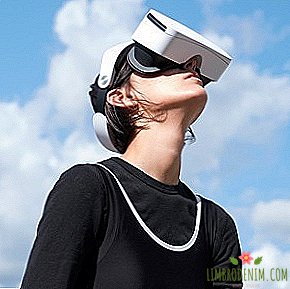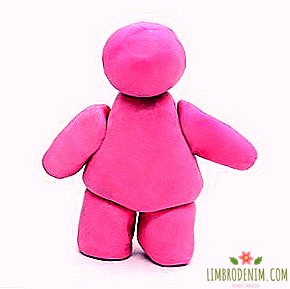“I burned my passport with VR glasses”: Catherine Nenasheva about actionism and isolation
LAST WEEK ART ACTIVIST KATRIN NENASHEVA completed her action "Between here and there", devoted to the conditions of detention in Russian psycho-neurological boarding schools (PNI). For 23 days, the artist walked around Moscow wearing virtual reality glasses, in which she looked at photos from the PNI, and was once detained by police officers who took her to a psychiatric hospital for examination. In the final of Nenashev's action, without removing his glasses, she burned the Russian passport.
Prior to this, the artist has held two notable actions: "Do not be afraid" and "To-order". The first was devoted to female prisoners: Nenasheva walked around the city in a prison uniform, sewed a Russian flag on Bolotnaya Square and shaved the head of the Kremlin. The “Nakazaniye” campaign, in turn, highlighted the problem of punishment and cruelty in orphanages, namely the forced detention in a psychiatric hospital. Nenasheva wore a hospital bed behind her back for three weeks, tried on punishments from orphanages in public places - ate salt, stood on peas, and at the end the artist made a dressing for Dmitry Zhdanov in a wheelchair in Alexandrovsky Garden.
Now Catherine plans to launch two more projects: "Intertourism" and "Psychosquash". We talked to the artist and found out what the new actions will be like, why all her performances are similar and how she is given friendship with the residents of psycho-neurological dispensaries.

 Why did you decide to do actionism?
Why did you decide to do actionism?
Since childhood, I was engaged in art: at first it was a music school and theater group, then the desire to tell stories about people, especially those who belong to specific social groups. I wanted to find my own way to make portraits of specific people and artistic text. After school, I entered the Gorky Institute of Literature and already there I tried to find the boundaries of poetic and prosaic, in which I would be comfortable. I always tried to get acquainted with different people and communities - so, once I began working in a charitable organization and went to a women's prison.
In general, my decision to turn to actionism, on the one hand, was influenced by the constant search for a convenient form for speech, and on the other hand, the accumulated experience of communicating with different people. At twenty, I made my first “Do not be afraid” action dedicated to female prisoners. For a whole month I wore a prison uniform, creating a certain performance, experimenting with my body and telling a story in text form using Facebook.
 You come from Krasnodar - are you familiar with local art? How was your move at all?
You come from Krasnodar - are you familiar with local art? How was your move at all?
I learned about the Krasnodar art only in Moscow and already then I began to study it. Much more important is the dissonance that I experienced because of the move: I acutely felt the lack of a cultural and social background, because of which I had to actively dive into a new, more complex environment. I tried to work with poetry and prose, even writing in a frankly pro-Putin newspaper. This experience, as well as my acquaintance with the Media Impact and curator Tatyana Volkova, influenced my search for form to a large extent.
 Did the Gorky Literary Institute, from which Dasha Serenko, the founder of the Quiet Picket action, was released, influenced you?
Did the Gorky Literary Institute, from which Dasha Serenko, the founder of the Quiet Picket action, was released, influenced you?
In a review of my thesis, one of the reviewers advised me to go to a mental hospital and said that only terrorists can hate Russia the way I do it. Now this university has become very conservative both in terms of the composition of teachers, and in the approach to learning, and in relation to the creative process. He seems to suppress everything productive and important for a young writer in people.
Rare activists appear precisely in spite of the nomenclature. Dasha turned to actionism not because of the university, but after the exhibition "NOT-WORLD", which was organized by art critic Sasha Lavrova, the art group "Rodina", me and Tanya Sushenkova. It is surprising that Dasha managed to gather like-minded people around him, including among students, which did not work out, for example, from me. It's cool, but works as an exception and resistance.
 In LIFE, performances are associated with a single event - yours are always stretched in time, for example, for a whole month. Why?
In LIFE, performances are associated with a single event - yours are always stretched in time, for example, for a whole month. Why?
I am still a bit ashamed to talk about this, but this is related to my personal artistic method, which works in conjunction with certain topics. I explore everyday life: my body experiences, the reactions of people around me — and in this format it is impossible to get results in one or two days.
I spent a month in prison uniform, twenty-one days — with an iron bed tied to my back, and twenty-three days — with glasses of virtual reality. It seems to me that during this time one can clearly see one’s own and others ’reactions to such an invasion of everyday life. In addition, my performances are the stories of certain social groups or several of their representatives. It is very difficult to talk about such a problem in a short time: we need a story that will obey a certain metaphor, and a finale that will arise in a complex process of performance. I never know how it will end, in advance.
 And what can be considered the result of performance?
And what can be considered the result of performance?
Most of the results occur in live time - while communicating with people or, for example, clashes with the walls in glasses of virtual reality. Even fatigue in the body after you carry an iron bed on your back all day, is an important thing. Unfortunately, many forms of summarizing the campaign are not available for Russian actionism. I would like to record the results of my research in classical forms - exhibitions or art albums, but often this is unrealistic.
Now my only museum is social networks, where one post with a report about the next day of the action lives for one or one and a half days. Of course, this largely reflects the reality in which we live, but at the same time makes it impossible for a deeper reflection that lasts longer than the rating of the publication on Facebook. Although I was able to talk about my art, first in the Krasnodar Center for Contemporary Art "Typography", and then quite accidentally get on the triennial in the "Garage". In the latter, I presented the “To-Action” campaign, thanks to which many people learned about it.
 What do you feel because of the impossibility to prolong the life of your performances?
What do you feel because of the impossibility to prolong the life of your performances?
I spend one action a year and after each of them I feel very depressed for a number of reasons, including because I feel that the opportunity to discuss and reflex another performance is slipping. This is aggravated by the fact that our art community does not take the activist form seriously.
But after the action dedicated to psycho-neurological boarding schools, my colleagues and I planned to make an artistic book, which would include photographs, artistic texts, and media publications on this topic. I would like to convey the experience of communicating with the PNI residents and go to more global forms than a Facebook post or even an interview that a couple thousand people read.
 How do you choose themes for performances?
How do you choose themes for performances?
Firstly, I was always interested in the topic of isolation, and secondly, I am guided by context and situation. But it is also important for me to be truly angry and to feel injustice before you start doing something. Suppose you learn about the ban on photographs of female prisoners or about the inexplicable death of a resident of a psycho-neurological boarding school.
All my actions are determined by the isolation construct, which either happens to the heroes now, or has happened in the past. What does isolation do to a person? How do you perceive a person who just got out of prison or an orphanage? These are questions that I am trying to answer.
Suppose, in the “Between here and there” action, virtual reality glasses allowed me to try isolation on myself, and the reaction of passersby showed how people relate to a person who is not built into the outside world. A "Nakazanie" shows how people live, not just going through violence. The bed behind the back is a metaphor for traumatic memories that always stay with us. But, of course, all actions are connected with the borderline of my own identity, body and change of social roles.
 How do you prepare for stocks?
How do you prepare for stocks?
Before the performances, I conduct an ordinary research paper: I read texts, both philosophical and thematic, and I also get acquainted with the characters. For example, before "Na-kazaniem" I talked with children from orphanages for nine months and became very close to them. I analyze people's characters, appeal to concepts and theories that interest me, such as Michel Foucault, the Russian avant-garde, and relativistic art.
 Obviously, every person has a fear of others. How do you manage to overcome it?
Obviously, every person has a fear of others. How do you manage to overcome it?
Interestingly, I am not afraid of people who are literally isolated, for example, residents of PSI, prisons or orphanages. It is much more terrible to encounter people in everyday life: on the market, in the metro, in shopping centers. The people around us are also in isolation of their own views, and it is rather difficult to find a common language with them when you encounter randomly. Many passersby do not understand that they are becoming spectators of the performance, and therefore react to me in a completely unexpected way.
 How did you decide to study the inhabitants of the Psycho-neurological boarding school?
How did you decide to study the inhabitants of the Psycho-neurological boarding school?
At first, the existence of such places and their closeness from the outside world became news for me. A volunteer group of female psychologists found out about my “Nazcation” action and invited me to watch PNI, a unique place where time and space are completely different. From the point of view of isolation, it is even worse than a prison, because prisoners sooner or later go free, the residents of such boarding schools do not.
Then I went to the event, which was organized by volunteers, for such people to take pictures. I asked to post pictures on The Village, and then I ran into a very strange problem. The PNI residents allowed me to post pictures, but then it turned out that legally they do not have the right to do so, that is, they are deprived of not only their legal capacity, but the rights to their own person, but they simply forbid me to trust these people. It made me very angry.
 What media did you use for this promotion?
What media did you use for this promotion?
After the publication of photos, various people began to join me, for example, the artist Vladimir Kolesnikov and the journalist Misha Levin. We began to think, through what media can you connect with people behind a concrete fence and how to tell about them to the outside world. First, we took a photo lab: we took pictures of faces and bodies to help the residents of the PNI find their own face, which they were deprived of, made unnecessary. For Russian culture, this is generally a standard story, where people with cerebral palsy, Down syndrome and a delay in the development of cognitive functions are completely cut off from their individuality.
We exchanged photos with them, replacing the possibility of direct communication. This helped not only to get acquainted, but also to find reasons for conversation. At the same time, I walked around the city and showed people photos of the PNI and its inhabitants. She came up to the subway, at exhibitions, at fairs - she just opened the album and almost forced to watch, then offered to take pictures for these people. In most cases, passers-by did not want to look, which is largely explained by the notion that if people are isolated, then they are “tattered psychos” who should not invade the outside world. For me it was important to show another reality that most people just don’t want to know about.
We also made a small social network for residents of various boarding schools using photos and video messages that they could send to each other. In Moscow alone, there are thirty such institutions, whose inhabitants are in no way connected with each other. Then we began to use video calls - first in a performative way, suggesting that people perform the same actions on the camera in order to lay the foundation for communication. And it ended with a "party over the fence", when people from different worlds gathered on both sides of the fence. At first, everyone danced with video broadcasting, and then they began to use the fence not as an obstacle, but as a net for volleyball.
 What difficulties have arisen in communicating with the residents of the orphanage?
What difficulties have arisen in communicating with the residents of the orphanage?
PNI is an extremely closed institution where people really want to communicate with the outside world, but often do not know how to do this. They have a special life and life, which has little resemblance to the one that happens "behind the wall". Often, difficulties in communication are not related to physiological and mental characteristics: many residents are quite healthy, but the system says that they have sluggish schizophrenia or some degree of mental retardation. Although the latter is often due to the fact that in the orphanage they were not taught to read and write, and poor diction is explained by the lack of classes with a speech therapist.
But to communicate with many PNI residents is really difficult. Many of them lack an identity, so they often have a poor understanding of how and when to speak. Many of them really want to communicate, but do not have their own voice and vocabulary. PNI residents are very responsive to the emergence of new people. And if there is such an opportunity (many of them got the hang of using the Internet), they add to you on all social networks and write: "Hello. How are you?" After this text, a problem often occurs - they simply do not know what to say next.
In addition, these people can not lie in any way, even in the framework of standard courtesy. It may require a lot of strength, cause irritation and fatigue. In ordinary life, if you are asked whether your communication will continue or whether you will come again, you will say yes, just to be polite. In the outside world it is very difficult to tell a person directly that you will not be friends with him or will not help him. In boarding school this is impossible, because your lies do not disappear anywhere - you will surely come across it on your next visit. And each time it becomes more and more difficult to speak the learned patterns and you have to learn to communicate again. However, they tell you in person what they think about your appearance, behavior, or even art. At some moments I could not stand it, and in general it is a very strange feeling of a split into a person of the outside world with one language and a visitor to the orphanage - with a completely different one.
 And how did the boarding staff react to your action?
And how did the boarding staff react to your action?
In PNI there are only chopovtsy, employees and doctors. In general, I was lucky, because now the reform of such boarding schools is being prepared: the working group is thinking how to introduce these people into a normal life. In Europe, such people have long been transferred to an accompanying residence. In addition, the boarding school, which we ended up in, was experimental, and the management made concessions and strange experiences like “Fence Parties”. People who work in boarding schools differ from each other in their attitude to the residents of psycho-neurological boarding schools and in their professional qualities. Although those who are ready for experiments often fall from top management - this is the standard Russian hierarchy system.
 Why did you wear virtual reality glasses after visiting the boarding school?
Why did you wear virtual reality glasses after visiting the boarding school?
The action with glasses tells about the borderline states that I felt while in the orphanage. I felt strange, coming to boarding school as a person with the maximum number of opportunities to visit my friends who do not have them. I had to re-learn how to talk and act.
Thus, I began to think about borderness and my other identities, for example, as an artist, a woman, a Russian citizen. That is why I clung to the construction of the real and the virtual, because I felt that I was between two realities: the outside world and isolation. I tried to limit myself to pictures and videos that PNI residents have been watching for decades, since they cannot leave its limits, and go out to the city with glasses. I also wanted to understand how people react to a person who does not see where he is going, who stumbles, does not know how to perceive sounds and communicate. This image symbolizes a person who falls from one world to another and feels confusion. And, of course, this is a story about the impact on our identity of new media - for example, virtual reality glasses.
During the campaign, my identity was changing rapidly, especially when I was detained on Red Square. In just a few hours I was both an artist and a mentally ill when I was sent for a medical examination. This led me to the idea that capacity does not guarantee stability, and to go out in the street with glasses - as if to appear in the outside world completely naked and defenseless.
 Why did you burn your passport in the final action?
Why did you burn your passport in the final action?
This is quite a symbolic action. According to the document of 1978, the passports of PNI residents are allegedly stored in fireproof vaults, and this detail very successfully superimposed on the experience of loss of individuality. I burned my passport — my universal identification mark in this world — without removing my glasses, which very clearly conveyed my experiences during this promotion.
 Are you going to continue the story with boarding schools?
Are you going to continue the story with boarding schools?
Having tried all these practices, we will continue two projects. Первый - это агентство "Межтуризм", где люди из интернатов, не бывавшие в городе по десять-пятнадцать лет, планируют прогулочные маршруты для обычных людей и будут направлять их по скайпу. В "Межтуризме" камера работает с двух сторон. С одной стороны, ведомый общается с жителем ПНИ и следует его указаниям, с другой стороны, интернатовец видит внешний мир.
We launched this project so that people who are not part of the creative community could get to know the PNI residents. It seems that the excursion is a very comfortable and understandable form that will not alienate people. We have already conducted several routes. For example, yesterday several people walked along the route of a PNI resident Sergei, who had not been to Moscow since 1994, and with him we opened a monument to Yesenin, met a woman with a Chihuahua and tried to find his old friend in the house. All this is reminiscent of reality shows.
The second project is “Psychosquash”, in which the PNI wall will be used as an object for the game. Squash originated in British prisons, so this is quite a symbolic story, and the first game will take place this Saturday.
Photo: Natalia Budantseva





